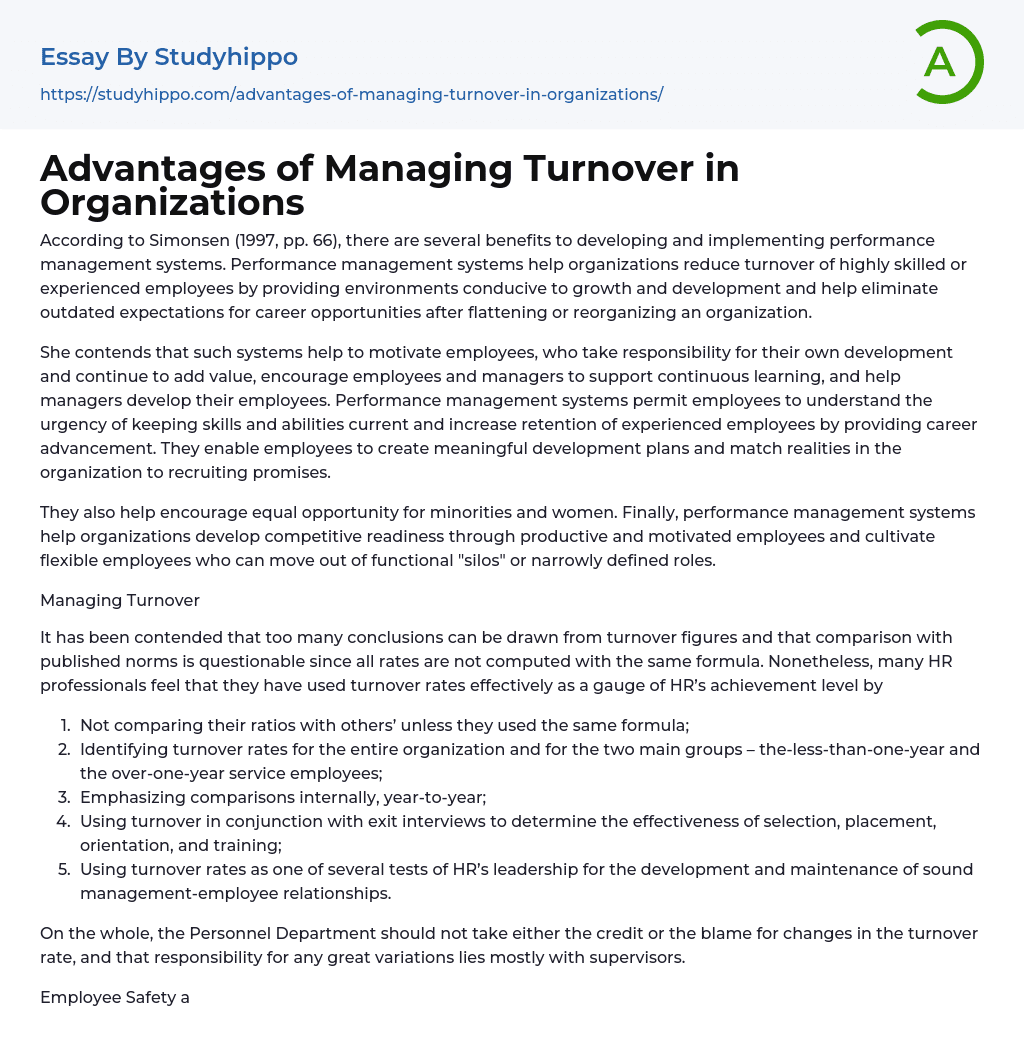

Advantages of Managing Turnover in Organizations Essay Example
According to Simonsen (1997, pp. 66), there are several benefits to developing and implementing performance management systems. Performance management systems help organizations reduce turnover of highly skilled or experienced employees by providing environments conducive to growth and development and help eliminate outdated expectations for career opportunities after flattening or reorganizing an organization.
She contends that such systems help to motivate employees, who take responsibility for their own development and continue to add value, encourage employees and managers to support continuous learning, and help managers develop their employees. Performance management systems permit employees to understand the urgency of keeping skills and abilities current and increase retention of experienced employees by providing career advancement. They enable employees to create meaningful development plans and match realities in the organization to recruiting promises.
They also help encourage equal opportunity for minorities and women. Finally, perf
...ormance management systems help organizations develop competitive readiness through productive and motivated employees and cultivate flexible employees who can move out of functional "silos" or narrowly defined roles.
Managing Turnover
It has been contended that too many conclusions can be drawn from turnover figures and that comparison with published norms is questionable since all rates are not computed with the same formula. Nonetheless, many HR professionals feel that they have used turnover rates effectively as a gauge of HR’s achievement level by
- Not comparing their ratios with others’ unless they used the same formula;
- Identifying turnover rates for the entire organization and for the two main groups – the-less-than-one-year and the over-one-year service employees;
- Emphasizing comparisons internally, year-to-year;
- Using turnover in conjunction with exit interviews to determine the effectiveness of selection, placement, orientation, and training;
- Using turnover rates a
one of several tests of HR’s leadership for the development and maintenance of sound management-employee relationships.
On the whole, the Personnel Department should not take either the credit or the blame for changes in the turnover rate, and that responsibility for any great variations lies mostly with supervisors.
Employee Safety and Health
Today most organizations are concerned about providing a safe and healthy workplace for their employees. But meeting that general goal is not easy; nor can all situations affecting employee health and safety always be anticipated. Nevertheless, organizational managers and HRM personnel have responsibilities for the health and safety issues of their organization. Part of this concern is simple humanitarianism. Few organizations would knowingly send unprotected employees into a dangerous situation.
Aside from altruism, there are two other reasons for organizational concern about the work environment. First, there are bottom-line performance consequences of mental and physical health. Second, state and federal laws require that reasonable levels of safety be maintained in the work environment. In today’s successful organizations, safety and health management concerns go beyond the physical condition of the workplace to regard for employees’ mental and emotional well-being and a commitment to protecting the surrounding community from pollution and exposure to toxic substances. As a consequence of the importance of safety and health, employees at all levels of the company are now involved. Costs of Work-Related Accidents and Illnesses The costs of work-related accidents and occupational diseases to American industry are known to be in the billions of dollars annually and are increasing in certain areas.
These costs are both tangible and intangible. The tangible costs are measurable financial expenses. One major category of these costs is directly
related to lost production. This category includes costs incurred as a result of work slowdown, damaged or idle equipment, damaged or ruined products, excessive waste, and any profit forgone due to lost sales.
A closely related cost is the cost incurred for training new or temporary replacements. Another category covers insurance and medical costs. These costs are increasing due to large claims and other expenses incurred as a result of work-related accidents. This category includes the costs of workers’ compensation insurance, accident insurance, and disability insurance (Fincham and Rhodes, 1999). The intangible costs of work-related accidents and illnesses include lowered employee morale, less favorable public relations, and a weakened ability to recruit and retain employees.
It is only natural that employee morale will suffer in an unsafe environment (Gratton et al, 1999). If a member of a maintenance team is injured, the harmony of the team may be impaired by the absence of the injured employee. A bad safety record may also be a major reason for poor employee relations with management. If employees perceive that their managers are unconcerned about their physical welfare, employee-manager relations can deteriorate. In fact, safety is often a primary reason for unionizing.
A poor safety record is also harmful to an organization’s public relations. It may deter customers from purchasing a business’s products or services. Frequently organizations ignore or are not aware of these and other “hidden” costs of occupational illness or injury.
- Anatomy and Physiology essays
- Addiction essays
- Biodegradation essays
- Dental Care essays
- Disease essays
- Disorders essays
- Health Care essays
- Intelligence Quotient essays
- Nutrition essays
- Olfaction essays
- Public Health essays
- Women's Health essays
- World health organization essays
- Cancer essays
- Infectious Disease essays
- Lung Cancer essays
- Neurology essays
- Physical Exercise essays
- Medicine essays
- Sex essays
- Inquiry essays
- Disability essays
- Poison essays
- Action Potential essays
- Nervous System essays
- Childbirth essays
- Puberty essays
- Blood essays
- Kidney essays
- Neuron essays
- Body essays
- Glucose essays
- Sense essays
- Heart essays
- Skeleton essays
- Human Physiology essays
- Eye essays
- Immune System essays
- Muscle essays
- Skin essays
- Brain essays
- Central Nervous System essays
- Human Skin Color essays
- Digestive System essays
- Common sense essays
- Respiration essays
- alcoholism essays
- Smoking essays
- Casino essays
- Tobacco essays



